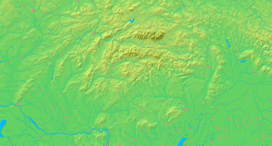Liptovský Mikuláš
| Liptovský Mikuláš | ||
| Town | ||
 Pictures from the top clockwise: - Pedestrian zone and the market square | ||
|
||
| Name origin: church dedicated to St. Nicholas | ||
| Country | Slovakia | |
|---|---|---|
| Region | Žilina | |
| District | Liptovský Mikuláš | |
| Tourism region | Liptov | |
| River | Váh | |
| Elevation | 577 m (1,893 ft) | |
| Coordinates | SK 49°05′03″N 19°36′08″E / 49.08417°N 19.60222°ECoordinates: SK 49°05′03″N 19°36′08″E / 49.08417°N 19.60222°E | |
| Area | 70.109 km2 (27 sq mi) | |
| Population | 32,786 (2006-12-31) | |
| Density | 468/km2 (1,212/sq mi) | |
| First mentioned | 1286 | |
| Mayor | Alexander Slafkovský | |
| Timezone | CET (UTC+1) | |
| - summer (DST) | CEST (UTC+2) | |
| Postal code | 031 01 | |
| Phone prefix | 421-44 | |
| Car plate | LM | |
  Location in Slovakia | ||
  Location in the Žilina Region | ||
| Wikimedia Commons: Liptovský Mikuláš | ||
| Statistics: MOŠ/MIS | ||
| Website: http://www.mikulas.sk/ | ||
Liptovský Mikuláš (Slovak pronunciation: [ˈliptowskiː ˈmikulaːʃ]; until 1952 Liptovský Svätý Mikuláš, German: Liptau-Sankt-Nikolaus; Hungarian: Liptószentmiklós) is a town in northern Slovakia, on the Váh River, about 285 kilometres (177 mi) from Bratislava. It lies in the Liptov region, in Liptov Basin near the Low Tatra and Tatra mountains. The town, known as Liptovský Svätý Mikuláš (or Liptovský Saint Nicholas) before communist times, is also renowned as a town of guilds and culture.
History
From the second half of the 10th century until 1918, it was part of the Kingdom of Hungary. The town of Mikuláš (Liptószentmiklós) was first mentioned in the royal deed of King Ladislaus IV in 1286. The first written record mentioning the Church of Saint Nicolaus which was to become the founding element of a larger settlement dates back to 1299. The Church of Saint Nicolaus is the oldest building in the town of Liptovský Mikuláš.
Mikuláš was one of the most important centres of crafts in the Liptov region. The craftsmen formed guilds. The oldest guild was the shoemaker's guild mentioned in 1508. There were also other guilds: the guild of smiths, furriers, tailors, hatters and butchers.
In 1677, Liptovský Mikuláš (Liptószentmiklós) became the seat of the local district, as well as Liptó county. The legendary Slovak "Robin Hood" Juraj Jánošík was sentenced and executed here in 1713 by being hung by the ribcage on a hook.
Liptovský Mikuláš played an important role for Slovaks in the 19th century during the period of magyarization. It was one of the centres of Slovak national movement. The first Slovak theater was founded there in 1830 called "The theater of G. F. Belopotocký". Liptovský Mikuláš was a home to an important Slovak romantic poet and national activist, Janko Kráľ, who was fighting for the right of self-determination of Slovak nation in the Hungarian Empire. Also another national revivalist Michal Miloslav Hodža lived there. The leader of Slovak national revival, Ľudovít Štúr, publicly revealed a document called "The demands of Slovak nation" in 1848 in Liptovský Mikuláš as an official appeal to the leaders of Austrian-Hungarian empire to help solve the present existentional problems of Slovak people (unsuccessful).
In the 20th century, many once independent villages were annexed to Liptovský Mikuláš. Thus, what was once the bucolic farmers' hamlet of Vrbica is now simply a street in the middle of the town.
Tourism
The town is one of the most famous tourist centres in Slovakia because of its rich cultural life and also because it is a perfect starting point for tourists, from where it is easy to reach the Low Tatras (Demänová valley) with well-known caves such as the Demänová Ice Cave or Demänová Cave of Freedom, or to the Western Tatras. Folk architecture can also be seen nearby in Vlkolínec near Ružomberok, or Pribylina, a few kilometres west of the town, and for recreation the lake called Liptovská Mara is available. Since 2004 a new aquapark called Aquapark Tatralandia has been open. The area is also well-known due to its location close to the biggest ski resort in Slovakia, Jasná. Many modern lifts and recent additions made to its infrastructure have meant it has become a popular ski centre for many western tourists over the last few years.
Demographics
According to the 2001 census, the town had 33,007 inhabitants. 94.07% of inhabitants were Slovaks, 2.30% Roma, 2.10% Czech and 0.28% Hungarians.[1] The religious make-up was 34.48% Roman Catholics, 32.26% people with no religious affiliation, and 26.85% Lutherans.[1]
Sport
Ice hockey: MHk 32 Liptovský Mikuláš played in the Slovak Extraliga until 2010, currently playing in the First League.
The Andrew Cibak Whitewater Slalom Course on the nearby Váh river is the oldest whitewater slalom course in Slovakia. The 2008 Olympic champion in canoe slalom, C-1, Michal Martikán was born and lives here. Also Elena Kaliská, another Olympic winner, is a member of the town sports club.
Liptovský Mikuláš hosted the 2012 FAI World Championship for Space Models, taking place from 31 August to 9 September.[2]
Transport
Liptovský Mikuláš is located near the main Slovak D1 motorway, as well as being on the main railroad from Bratislava to Košice. The closest international airport is in Poprad. The town also has its own public transport with 13 lines operating.
International relations
Twin towns – Sister cities
Liptovský Mikuláš is twinned with:
People
- Jozef Božetech Klemens (1817), painter
- Janko Kráľ (1822), poet
- Ján Levoslav Bella (1843), composer
- Aurel Stodola (1859), physicist
- Samuel Fischer (1859), publisher
- Slavoljub Eduard Penkala (1871), engineer, inventor
- Ivan Stodola (1888), poet, dramatist, doctor
- Martin Rázus (1888, Vrbica), priest, author, politician
- Janko Alexy (1894), painter
- Koloman Sokol (1902), painter
- Mária Rázusová-Martáková (1905), author
- Ladislav Hanus (1907), philosopher, theologian, author
- Pavol Strauss (1912), doctor, writer, essayist, translator
- Ivan Laučík (1944), poet, professor
- Michal Martikán (1979), sportsman
- Peter Sejna (1979), AHL/NHL player
- Martin Cibák (1980), 2004 Stanley cup winner with Tampa Bay Lightning
- Milan Jurcina (1983), NHL player
- Diana Doll (1976), model
Images
 Fountain
Fountain Town centre
Town centre Janko Kráľ's monument.
Janko Kráľ's monument. Saint Nicholas' Church
Saint Nicholas' Church Synagogue
Synagogue
References
- Notes
- 1 2 "Municipal Statistics". Statistical Office of the Slovak republic. Archived from the original on 2007-12-17. Retrieved 2007-12-28.
- ↑ "FAI Portal". FAI Sporting Calendar - Aeromodelling Category 1 Events. Federation Aeronautique Internationale (FAI). Retrieved 5 July 2011.
- ↑ "Testvértelepülések". Retrieved 30 April 2014.
- ↑ "Internetowy Serwis Miejski". zywiec.pl. 2008-06-20. Retrieved 2011-06-03.
